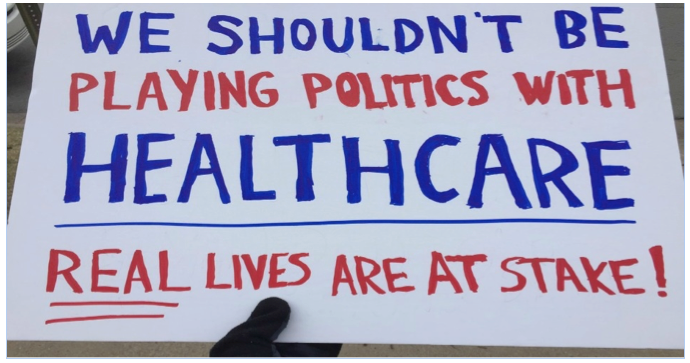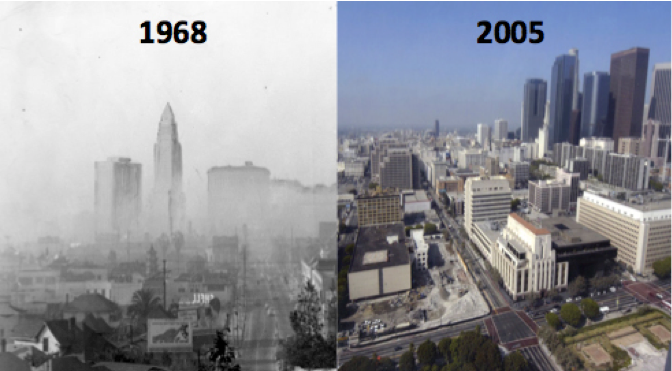Can LA’s Tech Oligarchs Thrive Under Trump?
NEW GEOGRAPHY--With the first billionaire in the White House, Wall Street booming and, for the first time in almost a decade, very solid and broad based job growth, one would think America’s business elite would be beaming. But that’s not so because the country’s moguls are more divided than at any time in recent history.
This conflict stems largely from divergent interests among rival factions of the putative ruling class. Trump’s backers tend to have links with the “real” economy, that is, those people who make things, such as energy producers, domestic manufacturers, agribusiness, suburban home-builders, and aerospace firms. These interests are increasingly concentrated in parts of America Trump painted “red”—the South, the Midwest, the Great Plains, and Appalachia.
On the other side lies the “ascendant” ephemeral economy, based in such industries as media, entertainment, software, and social media, as well as their financial backers. These industries are less affected by environmental regulations than those in more tangible lines of business. They are also concentrated in the deep blue slivers along the coasts and in college towns, the very places where the progressive social and environmental agenda is most deeply entrenched.
Obama’s Legacy: A New Post-industrial ruling class
Barack Obama’s most “transformative” achievement was the consolidation of this potentially hegemonic, post-industrial ruling class. They reaped high returns from the Obama era embrace of ultra-low interest rates, nudging billions into risky tech ventures and speculative urban real estate. These increasingly oligopolistic interests also benefited from a Justice Department that eschewed anti-trust inquiries in such areas as smartphone operating systems, search, and social media, where the main players often control 80 and even 90 percent share globally. IT, telecommunications, and media now compose America’s most concentrated sector and is consolidating somewhat faster than older industries, such as manufacturing, property. and wholesale trade.
In the past, Democrats received some support from business, but the GOP ruled the corporate mainstream. As William Domhoff illustrated in his classic study Fat Cats and Democrats, Democrats drew support from outsiders, some of them less than savory, in industries from energy, real estate, and gambling (Trump himself was a long-time Democrat). They also drew on diverse industries. As recently as the Bill Clinton years, Bill White, a savvy oil and gas attorney from Houston, served as chairman of the Democratic Party. It is doubtful now that someone with that background, even with White’s prodigious skills, will again be allowed into the party’s inner sanctum.
Obama’s post-industrial corporate elite emerged in his first 2008 election, with Google, Microsoft, Time Warner, IBM, and General Electric (NBC) ranking among the largest business donors. During his time in office, companies like Google enjoyed unprecedented access to the White House: More than 250 people moved between jobs at Google or related firms, the federal government, and Democratic political campaigns.
In the process, the technology and media oligarchies became core funders of the Democratic Party. This could prove more important in the future, as six of the ten and eight of the top 15 richest people on the planet, according to Forbes, derive their fortunes from these businesses. And this could just be the beginning: All of the 12 richest entrepreneurs under 40 come from the tech industry.
Even Hillary Clinton, a far less appealing figure than Obama, garnered most of the big money from tech oligarchs and their employees. Open Secrets notes that among private firms the largest business donors to her campaign included tech media establishments, including Alphabet (Google’s parent company), Microsoft, Apple, Time Warner, and Comcast.
Trump’s victory shocked this cozy alliance, and placed them in opposition. Silicon Valley, along with its idiot aunt, Hollywood, are now the most likely business constituencies to go into hysterics over the most recent inane Trump tweet, with some CEOs active participants in the anti-Trump “resistance.” Those few in Silicon Valley who backed Trump, like Peter Thiel, are now subject to campaigns to drive them from prominent boards. Uber’s Travis Kalanick, himself a rather unpleasant character, has been forced by such pressure to remove himself from any association with the current White House.
Ideology here mixes with self-interest. Mark Zuckerberg, whose $50 billion net worth makes him easily the wealthiest American under 40, recently issued a pronunciamiento that places his company’s objective as far from Trumpian nationalism as possible. He wants to create “a global community” even though his industry has helped foster the most social isolation since people discovered caves. His vision of the future, notes Bloomberg’s Leonid Bershidsky, offers something of a “social dystopia” run by Facebook’s management, with terms of discussion powered by computer algorithms.
It’s clear what won’t make the cut in Zuckerberg’s “community”: Facebook is increasingly hostile to any dissenting opinions from the right. The traditional media now wholly or partially owned by the “ephemeral” economy oligarchs—Jeff Bezos’s Washington Post, Microsoft’s MSNBC and Carlos Slim’s New York Times—have also joined the anti-Trump “resistance,” having just previously served as claques for Obama and Hillary Clinton. Newsrooms may always have tilted somewhat to the left, but today they seem about as objective as those in Putin’s Russia or, for that matter, Fox News.
Immigration may be the biggest hot button issue separating the oligarchs from a White House that has fanned nativist flames. But for them, embracing immigration—most notably the odious HIB visa program—does not mean adhering to legal norms or American traditions. Instead, their immigration vision fits that of companies seeking indentured tech servants as well as a cheap and inexhaustible supply of undocumented cheap dog-walkers, toenail painters, and nannies.
For this constituency, neither Trump’s proposed infrastructure program nor his moves to deregulate the economy have much appeal. After all, the Bay Area oligarchs seem perfectly fine with California’s regulatory insanity, and the piteously poor condition of the state’s infrastructure. Who needs roads and bridges when you have the cloud?
Of course, not all the new ruling class can dismiss Trump so haughtily. Elon Musk, a Hillary supporter who still sits on the new president’s economic council, needs skilled tradespeople and reasonable regulation to build electric cars and rockets. He yearns to play a role in Trump’s “lunar gold rush.” Caught in the middle, Musk is trying to make nice even in the face of assaults sent to him from the “resistance.”
Trump’s Oligarchs: Old School and Middle Class Friendly
The Obama oligarchs, like establishmentarians everywhere, clearly missed what the Chicago sociologist Richard Longworth predicted two decades ago: that rapid globalization, now known as Davos capitalism, would cause a full scale “social crisis.” The middle and working classes, as the Guardian has correctly noted, have little reason to love “superstar” oligarchs who employ few of them and, according to a recent paper by the Bureau of Economic Research, are a primary reason for the growth of inequality.
Trump’s oligarchs, for their part, reflect interests that jibe more closely with those of many middle and working class families. Trump’s so called “cabinet of billionaires”—their net worth is estimated at $14 billion—rightly has elicited criticism from the Guardian and Mother Jones, which predictably also labeled them a bit too pro-Russian. And to be sure, Wall Street’s hoary hand, notably the ubiquitous Goldman Sachs, has secured top posts at both the Treasury and the head of the National Economic Council.
Nonetheless, these billionaires have embraced a president who trolls corporations sending jobs overseas and bullies foreign firms, like Softbank, into committing themselves to major employment in the states. Obama and his academic coterie might dismiss such behavior as unseemly, darkly nationalistic and even ahistorical, but there may well be political gold there.
Of course, self-interest is a guiding factor, something particularly evident in the energy industry. The Trump cabinet features Rex Tillerson, former CEO of Exxon Mobil, as its secretary of State, Rick Perry, former governor of Texas, as Energy secretary, and Oklahoma’s former attorney general, Scott Pruitt, as director of the EPA. David Wolff, one of the Houston’s largest land owners, notes the change of administration has sparked renewed optimism across the energy belt. “It is nice to have a president who doesn’t hate your major industry,” Wolff quips.
Many manufacturers—at least those who build products here—also have reason to celebrate the Trump ascension. A lot of firms felt threatened by the Democrats’ regulatory regime, which threatened to boost their energy and other costs. They also were the primary victims of globalist trading polices embraced by the grandees of both parties. The 79-year-old billionaire Wilbur Ross, the new Commerce secretary, made his fortune by buying and selling companies in such trade-impacted sectors as steel, textiles, and coal. Trade advisor Peter Navarro is well-known for pushing neo-protectionist and nationalist policies abhorred by the new oligarchs but popular in large parts of the country.
Interregnum or Change of Direction?
To the increasingly disconnected and increasingly concentrated blue state media, Ross and his ilk may epitomize an unhealthy attraction to “backward” sectors that need to be “disrupted” by the geniuses of Silicon Valley. Given their sense of historical inevitably, the tech oligarchs may feel that this shift is just a temporary halt in their drive, as notes Newsweek’s Michael Wolff, to create “a more careful, regulated, and corrected world.”
Yet many more Americans—particularly blue collar Americans—may prefer the Trump approach. Manufacturing employs some 11 million workers compared to 2.7 million in information. Both have seen their share of jobs go down since 2004, but, suggests the Bureau of Labor Statistics, industrial jobs are likely to remain six times as numerous by 2024. Throw in the mining sector, which includes energy, and the difference is expected to be roughly 9.4 million jobs compared to 2.4 million in the information sector.
Ironically, the workforce in these industries is far more diverse than in those businesses run by the Obama oligarchs, who loudly champion the rainbow ideal but rarely in practice. Silicon Valley employs very few African-Americans or Hispanics; they make up barely 6 percent, for example, of Facebook’s workforce while overall leading tech firms employ barely 5 percent. In contrast, according to 2015 data, 16.2 percent of manufacturing workers are Latinos and 9.7 percent are African-Americans. In mining, quarrying, and oil and gas extraction, Latinos make up 16.9 percent of the workforce and African-Americans 4.8 percent, while in agriculture, forestry, fishing, and hunting, nearly a quarter of the workforce—23.0 percent—is Latino and 2.7 percent African-American.
If Trump policies can unleash a boom in these industries, he may have more staying power than many in the chattering classes admit. At least the Trumpians offer the prospect of upward mobility, greater independence, and the pride of work. In contrast, Silicon Valley’s vision, notes Greg Ferenstein, who has researched the views of the post-industrial elite, suggests a world where a “greater share of economic wealth will be generated by a smaller slice of very talented or original people”—that is, the denizens of Silicon Valley. “Everyone else,” he continues, “will increasingly subsist on some combination of part-time entrepreneurial ‘gig work’ and government aid. “
One has to wonder whether the prospect of widespread downward mobility for all but the “best and brightest” will prove very attractive to the majority of Americans. In contrast, Trump’s outsized promises, however unrealistic, may retain surprisingly long-term appeal.
Trump’s business cronies may be grizzled, and even reactionary. They still may well end up as anachronisms, the last devotes of a dying industrial, largely white, America. But the Trump interregnum could become a new dominant paradigm if the Obama oligarchs fail to develop a vision that allows a better future than the jobless, socially stagnant and politically correct one now on offer.
(Joel Kotkin is executive editor of New Geography … where this analysis was first posted. He is the Roger Hobbs Distinguished Fellow in Urban Studies at Chapman University and executive director of the Houston-based Center for Opportunity Urbanism. He lives in Orange County, CA.)
-cw









 Looking back, it’s easy to see similar factors and growth patterns in other Sunbelt cities like Houston, San Diego and later Phoenix. But Los Angeles was the only city with a potent enough combination of cheap and open land, a strong economy and good weather in the prime time of Western settlement to sustain a population boom that lasted decades.
Looking back, it’s easy to see similar factors and growth patterns in other Sunbelt cities like Houston, San Diego and later Phoenix. But Los Angeles was the only city with a potent enough combination of cheap and open land, a strong economy and good weather in the prime time of Western settlement to sustain a population boom that lasted decades. 


























